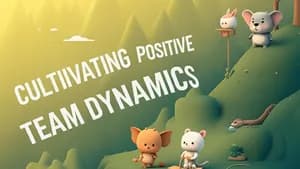Conflict is inevitable in any team, but it doesn't have to be destructive. Learn how to address conflicts constructively, using active listening, empathy, and compromise to reach a mutually acceptable solution.
Understanding Conflict: A Necessary Part of Collaboration
Think about your favorite team sports. Imagine a basketball game where everyone agrees on every move. That sounds boring, right? In reality, disagreements and different perspectives are what make teams dynamic and engaging. Conflict, when managed effectively, can become a catalyst for innovation and growth.
In your studies, you'll encounter different ideas, diverse approaches, and varying opinions, just like on a basketball court. Embracing this diversity is crucial for creating a dynamic learning environment. Remember, conflict isn't necessarily bad; it's how you address it that determines its impact.
Active Listening: Hearing Beyond the Words
Imagine you're working on a group project. One member proposes a strategy you disagree with. Your natural instinct might be to jump in and explain why you think it's wrong. However, before you defend your perspective, practice active listening.
Active listening means truly understanding the other person's point of view. It's about paying attention not only to their words but also their tone, body language, and emotions. Ask clarifying questions like "Can you tell me more about why you think this approach is best?" or "What are the main reasons behind your proposal?"
By actively listening, you'll be better equipped to understand their rationale, identify any misunderstandings, and formulate a thoughtful response.
Empathy: Stepping into Another's Shoes
Empathy is about seeing things from another person's perspective, even if you don't fully agree with them. It's about trying to understand their feelings, motivations, and challenges. Imagine yourself in their situation and try to see things from their point of view.
For example, if a teammate is constantly late to group meetings, try to consider their perspective. Perhaps they have a family commitment that makes it difficult to be punctual. Instead of getting frustrated, try to empathize with their situation and find a solution together.
Effective Communication: Bridging the Gap
Communication is the key to navigating conflict effectively. This involves speaking your truth respectfully and actively listening to others. It's about finding common ground and focusing on solutions, rather than dwelling on differences.
When communicating during a conflict, avoid making assumptions and personal attacks. Use "I" statements to express your feelings and needs, like "I feel frustrated when..." or "I need..." This promotes a more constructive conversation, preventing defensiveness and blame.
Finding Common Ground: The Power of Compromise
Compromise is about finding a solution that satisfies everyone, even if it means making some concessions. It's about finding a middle ground that respects everyone's needs and perspectives.
In a team project, you might not get everything you initially wanted. But by finding a compromise, you can still achieve the group's overall goals. For example, if your group is debating between two research approaches, you could agree to combine elements of both. This way, you can leverage the strengths of each approach and create a more comprehensive solution.
Putting it All Together: A Step-by-Step Guide
Here's a practical guide for navigating conflict in your studies:
-
Identify the Issue: Clearly understand the root of the conflict. What is the specific point of contention? What are the different perspectives involved?
-
Active Listening: Pay close attention to what each person has to say. Ask questions for clarification and strive to understand their feelings and motivations.
-
Empathy: Try to see things from their perspective. Put yourself in their shoes and consider their unique challenges or limitations.
-
Communicate Respectfully: Express your thoughts and feelings clearly and respectfully, using "I" statements. Listen attentively and be open to hearing their perspective.
-
Find Common Ground: Identify areas of agreement and leverage those shared interests to build a solution.
-
Compromise: Find a mutually acceptable solution where everyone feels their needs are met, even if it means making some concessions.
Conclusion: Conflict as a Stepping Stone to Growth
Remember, conflict is a natural part of collaboration. How you choose to navigate those conflicts can either hinder your progress or accelerate it. By practicing active listening, empathy, and effective communication, you can transform conflict into a catalyst for growth, understanding, and stronger teamwork. So embrace those disagreements, navigate them with grace, and learn to use them as stepping stones towards achieving your academic goals.

